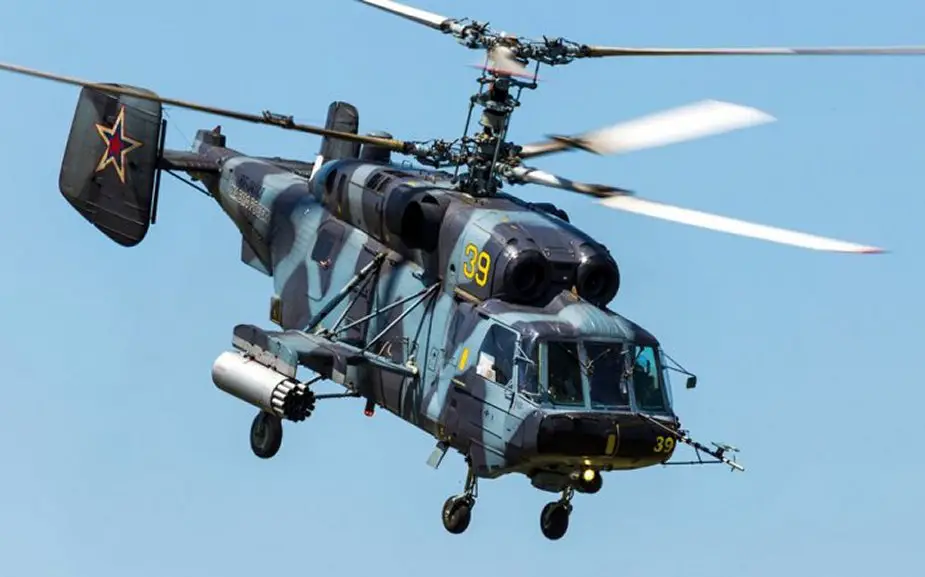Breaking news
Russia: upgraded Kamov Ka-29 helicopters to operate in Arctic.
Squadrons of upgraded Ka-29TB (Transportno Boyevoy) helicopters will operate in the Arctic. Kamchatka pilots of the Pacific Fleet are the first to operate them. Ka-29s have been prepared for Polar missions since early 2020. The Northern Fleet will begin operating them in 2021. The helicopters will supply military bases, airlift troops and patrol the Polar region. Experts said that the Ka-29 is universal, carries powerful arms and can airlift several tons of cargo, the Izvestia daily writes.
Follow Air Recognition on Google News at this link

Kamov Ka-29 (Picture source: Oruzhie.info)
Russian Defense Ministry sources said the decision in principle to engage Kamov Ka-29 (NATO code: Helix-B) in the Arctic had been made. Until recently, Mi-8AMTSh (including Arctic Mi-8AMTSh-VA option), Mi-26 and seaborne Ka-27 have been used.
The Arctic Ka-29 is operated by the 317th Combined Air Regiment deployed near Petropavlovsk-Kamchatsky. There are two units of four helicopters each. The Northern Fleet followed Kamchatka and obtained Ka-29s. The upgraded helicopters are operated by the 830th Naval Antisubmarine Regiment deployed near Severomorsk.
Batch production of the Ka-29 began in 1980s, but it is not an outdated rotorcraft, expert Dmitry Boltenkov said. "Kamov helicopters can operate from land and warships. The upgraded helicopter will serve for long due to its firepower, transport capacity and airborne assault capabilities. In the Arctic, the Ka-29 can patrol uninhabited territories, participate in counter-subversion and rescue operations, and deliver supplies to remote northern garrisons and military bases," he said.
At present, pilots are training to fly the Ka-29. Northern Fleet pilots have recently trained support to assault forces in bad weather, as well as navigation in the Extreme North. An exercise was held in June in Kamchatka and engaged Pacific fleet helicopters. They attacked coastal and sea targets and destroyed fortified firing positions, hardware and assault forces. They fired 80mm unguided missiles and GSh guns.
Over 60 Ka-29s were produced. They were initially intended for cargo transportation, amphibious assault and fire support. The helicopters had to expand the capabilities of big amphibious assault ships of project 1174 capable of carrying four helicopters. However, these helicopters were stored in the Russian European north and Kamchatka after the fleets were reduced. "The return of the helicopters after 25 years of idle life confirms the capabilities and a good potential of the industry," Boltenkov said.
A program to overhaul, upgrade and restore technical readiness of seaborne Ka-29 has been adopted. The upgraded helicopters changed the lifting rotor mast, engines and reducers and renewed the coating paint. They received modern arms and electronic equipment, he said.
The helicopter can carry 16 paratroopers at a cruising speed of 235 km/h. Four suspensions carry unguided missiles, gun containers and bombs. The rotorcraft can fire antitank missiles. The cockpit, important mechanisms and engines are armored against rifle bullets. Screens may be installed at the engine exhaust to protect the helicopter against heat homing missile warheads and optical-electronic jamming.
Kamov helicopters have been tested by time. The transportation cabin can accommodate close to two tons of cargo. Another four tons can be carried on suspension. The capability is necessary to airlift troops between warships and supply remote Arctic territories, in particular, autonomous military bases, such as the one in Alexandra Land of Franz-Joseph Land Archipelago. The Severny Klever base was built in Kotelny Island of Novosibirsk Islands. The Polar Star was built in Wrangel Island. A similar base exists in Otto Schmidt Cape in Chukotka, the Izvestia said.
© Copyright 2020 TASS. All rights reserved. This material may not be published, broadcast, rewritten or redistributed.


























